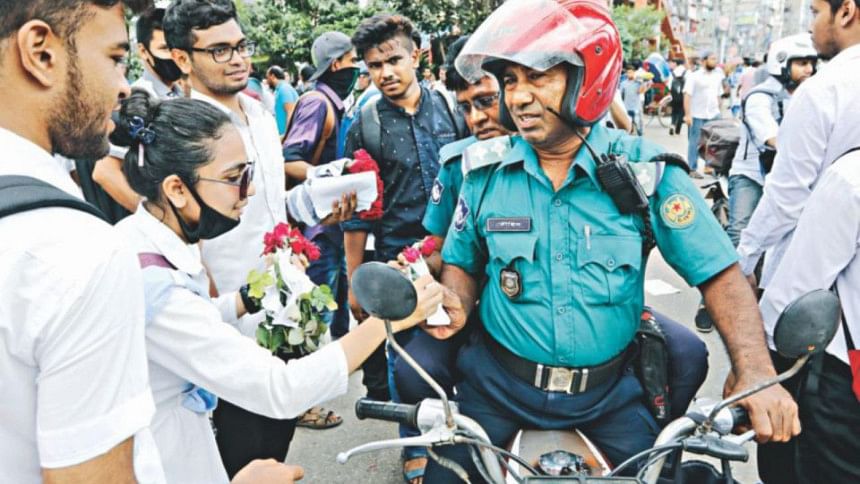How social media breeds social movements

Observers in Bangladesh are still grappling to figure out the sudden and powerful student movement that paralysed the capital city over a demand for safe roads. The movement began when a minister grinned on camera, apparently dismissing the deaths of two college students who were killed by a speeding bus. A video clip of the minister's response went viral in social media and led to a movement the likes of which Bangladesh has never experienced before. It bears a resemblance to all the social media-driven movements that we have seen in other parts of the world in recent years.
Social media has connected people from almost every walk of life all over the world. According to an estimate, a whopping 3.3 billion people, about half of the total population of the world, used some form of social media in January 2018. Even though the overall penetration of social media is still low in Bangladesh, according to a report by The Daily Star, Dhaka boasts the second largest number of active Facebook users in the world. Users are engaged in a variety of activities, such as maintaining personal connection, getting news, looking for information, finding entertainment. But one particular use of social media—getting engaged socially and politically—needs to be looked into, because it has the potential for positive social change.
But apparently, we only see the outrage in social media. For example, Bangladeshi users reacted strongly to the graphic images of protesting students being beaten by those opposing the movement. The recent killing of Teknaf Municipality councillor Akramul Haque created outrage in social media. A host of other incidents including the rape and murder of Tonu in Comilla also captured national attention. We observed social media's role during the trial of some war criminals of the 1971 war of independence. Social media, especially Facebook, Twitter and Youtube, often helped keep the cause for a movement/protest alive. In many cases, the mainstream media were slow to report or respond, but were prodded into action after social media users got louder and angrier.
All available evidence suggest that the recent student movement demanding road safety was indeed a social media-driven event. It's similar in nature to other social media-inspired movements. In Iceland and Spain, social media played pivotal roles in spreading anger, organising protests on the streets, and in some cases, bringing about positive outcomes. So, the question is: what makes social media such a potent force for social mobilisation?
Manuel Castells, a Spanish social scientist, has been studying social networking and recent social movements and published books and articles on this. He provides a plausible and comprehensive theoretical explanation of social media's role in social movement. He argues that social media triggers some of the basic human emotions such as anger and fear. Stories of injustice and human sufferings surface in social media in personal frames, accompanied by strong, often provocative images. These stories usually go viral as users share them in their networks. Usually, tech-savvy, young urban populations take leading roles in the ensuing movements. Recent developments in the realm of information and communications technology have shifted the balance of power from government and traditional media to end-users. Social media users have become producers and can convey their messages to networked mass audiences, bypassing the scrutiny of the government and the content editors of traditional media.
In other words, the Internet and mobile technologies have greatly democratised public spheres. This democratisation has turned social media into a powerful tool for social movement.
However, social media alone cannot trigger a movement. There should be what the scholars call "objective conditions" for any movement to take place. Conditions such as oppression, injustice, lack of freedom, or limited economic opportunity create a fertile ground for social movement. One of the common themes of social movements today is the general people's dignity. When people's dignity is violated and their cry for justice is ignored by the ruling elite, social movements begin to incubate from within the society. All that is needed then is a dramatic incident to trigger it.
In the case of the recent student movement, it was ignited by the video clip of the said minister's smirk and dismissive comments.
It can be noted that the Arab Spring began when a Tunisian street vender set himself on fire because he could not provide for his family and experienced repeated police abuse. The image, which was taken by a camera phone, went viral and set in motion a chain of events leading to a historic movement that caused the collapse of some powerful regimes in the Middle East. But the question is: how do social media-driven movements survive?
Castells argues that people are driven by anger but at the same time, they are also driven by fear—fear of repercussions. But they overcome that fear thinking that they are not alone; there are others in the networked community that is equally outraged. Thus, social media provides a platform for mobilisation and organisation of protests. Students involved in the recent movement in Bangladesh have reportedly used social media tools for mobilisation and orchestration of the protests. It is surprising that these types of movements can survive for weeks and even months without any formal organisation and established leadership.
Another interesting feature of this type of movement is: the protesters occupy urban spaces and they use the spaces not only to protest but also to create audio-visual materials and share those in their networks. We have seen how the protesting students literally took control of Dhaka's traffic system and recorded hundreds of videos and shared them online. Thus, the occupation of urban spaces and social media creates a symbiotic relation that feeds each other and helps sustain the movements.
Over the years, governments have learned how to control social media-inspired movements. Some of the techniques are crude such as shutting down the Internet, blocking certain online platforms and other measures. In some cases, governments use extereme force to suppress the movements. But the protests may always resurface in one way or another unless the underlying issues are resolved.
Shafiq Rahman is a Professor of Communication at Chadron State College in Nebraska, USA.





Comments